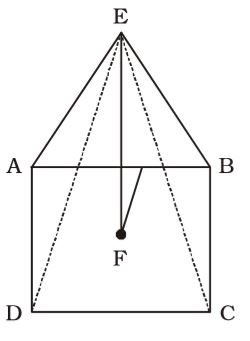Mensuration
- If the slant height of a right pyramid with square base is 4 metre and the total slant surface of the pyramid is 12 square metre, then the ratio of total slant surface and area of the base is :
-
View Hint View Answer Discuss in Forum
Let the length of each side of base be x metres, then
1 × perimeter of base × slant height = 12 2 ⇒ 1 × 4x × 4 = 12 2 ⇒ x = 12 = 3 metre 8 2 ∴ Area of the base = 9 sq. metre 4 ∴ Required ratio = 12 : 9 = 16 : 3 4 Correct Option: A
Let the length of each side of base be x metres, then
1 × perimeter of base × slant height = 12 2 ⇒ 1 × 4x × 4 = 12 2 ⇒ x = 12 = 3 metre 8 2 ∴ Area of the base = 9 sq. metre 4 ∴ Required ratio = 12 : 9 = 16 : 3 4
- The base of a right pyramid is a square of side 16 cm long. If its height be 15 cm, then the area of the lateral surface in square centimetre is :
-
View Hint View Answer Discuss in Forum

Height of the triangle = √15² + 8²
= √225 + 64 = √283
= 17 cm
∴ Area of the lateral surface of pyramid = 4 × Area of triangle= 4 × 1 × base × height 2 = 4 × 1 × 16 × 17 = 544 sq.cm. 2 Correct Option: B

Height of the triangle = √15² + 8²
= √225 + 64 = √283
= 17 cm
∴ Area of the lateral surface of pyramid = 4 × Area of triangle= 4 × 1 × base × height 2 = 4 × 1 × 16 × 17 = 544 sq.cm. 2
- The base of a right prism is an equilateral triangle of area 173 cm² and the volume of the prism is 10380 cm³. The area of the lateral surface of the prism is (use √3 = 1.73)
-
View Hint View Answer Discuss in Forum
Volume of right prism = Area of the base × height
⇒ 10380 = 173 × h⇒ h = 10380 = 60 cm 173
Now, Area of triangle= √3 × (side)² 4 ⇒ 173 = √3 × (side)² 4 ⇒ 173 = √3 × (side)² 4
∴ Perimeter = 3 × 20 = 60 cm
∴ Area of the lateral surface = Perimeter of base × height = 60 × 60 = 3600 sq.cm.Correct Option: C
Volume of right prism = Area of the base × height
⇒ 10380 = 173 × h⇒ h = 10380 = 60 cm 173
Now, Area of triangle= √3 × (side)² 4 ⇒ 173 = √3 × (side)² 4 ⇒ 173 = √3 × (side)² 4
∴ Perimeter = 3 × 20 = 60 cm
∴ Area of the lateral surface = Perimeter of base × height = 60 × 60 = 3600 sq.cm.
- The base of a solid right prism is a triangle whose sides are 9 cm, 12 cm and 15 cm. The height of the prism is 5 cm. Then, the total surface area of the prism is
-
View Hint View Answer Discuss in Forum
Perimeter of triangle
S = 9 + 12 + 15 = 18 cm 2
∴ Area of triangle = √s (s - a)(s - b)(s - c)
= √18(18 - 9)(18 - 12)(18 - 15)
= √18 × 9 × 6 × 3 = 54 sq.cm.
∴ Total surface area of the prism = Perimeter of base × height + 2 × Area of base
= 36 × 5 + 2 × 54 = 288 sq.cm.Correct Option: C
Perimeter of triangle
S = 9 + 12 + 15 = 18 cm 2
∴ Area of triangle = √s (s - a)(s - b)(s - c)
= √18(18 - 9)(18 - 12)(18 - 15)
= √18 × 9 × 6 × 3 = 54 sq.cm.
∴ Total surface area of the prism = Perimeter of base × height + 2 × Area of base
= 36 × 5 + 2 × 54 = 288 sq.cm.
- If the total surface area of a hemisphere is 27π square cm, then the radius of the base of the hemisphere is
-
View Hint View Answer Discuss in Forum
If the radius of hemisphere be r cm,
then 2πr² + πr² = 27π
⇒ 3πr² = 27π
⇒ 3r² = 27
⇒ r² = 9
∴ r = 9 = 3 cmCorrect Option: B
If the radius of hemisphere be r cm,
then 2πr² + πr² = 27π
⇒ 3πr² = 27π
⇒ 3r² = 27
⇒ r² = 9
∴ r = 9 = 3 cm

